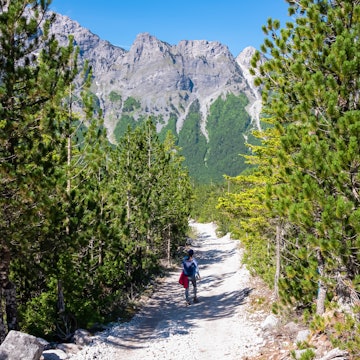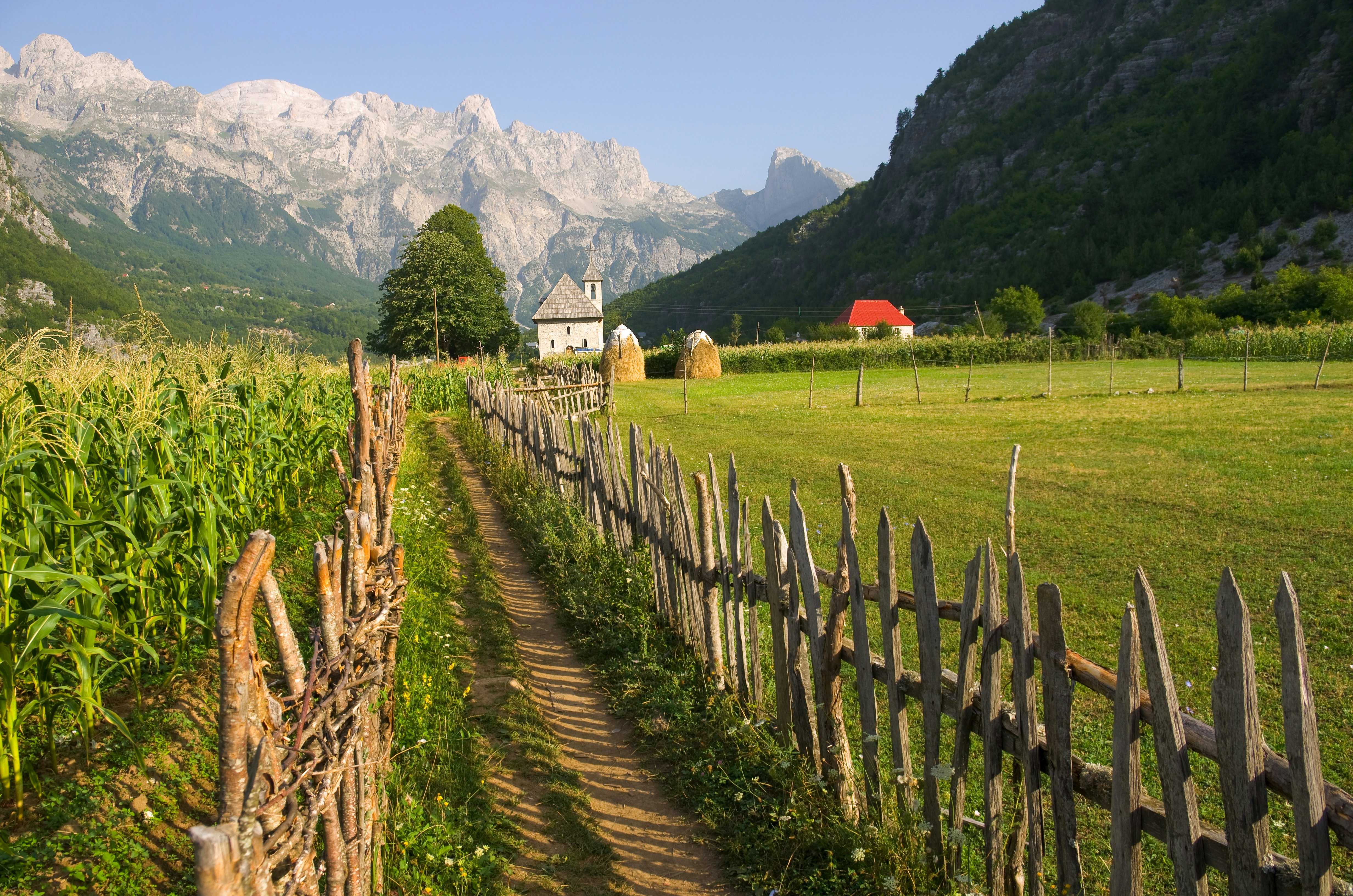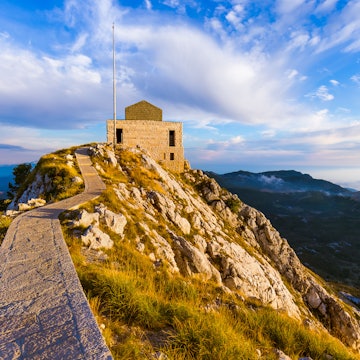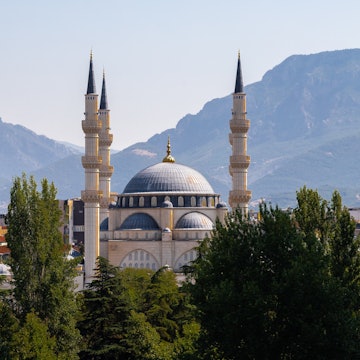

Pull yourself way from the beaches of Ksamil and pop over to the ancient city of Butrint nearby. trabantos/Shutterstock
Move over Italy, Greece and Croatia – it’s Albania’s time to shine. This southwestern Balkan country has gone viral for its beaches’ bluer-than-blue water – attracting a steady stream of sunseekers every summer. But that’s not all this little country has to offer. Explore Albania’s thriving capital, Tirana, on a bar crawl and go inside its bunker museums – leftovers from its 45-year dictatorship. Wander through UNESCO-recognized Berat and Gjirokastër, two stunning stone cities, and feel like you’ve gone back in a time machine, and hike over spectacular the Accursed Mountains (Albanian Alps).
Read on for 15 fun things to do in Albania.

1. Beach hop along the Albanian Riviera
Albania’s white sand and pebble beaches along its western coastline are well worth the hype. There’s crystalline water, islands you can swim to, and tasty seafood at reasonable prices. The bluest water is in and around the town of Ksamil on the southwestern Ionian coast, but there are plenty more beaches to explore (with fewer crowds). Road trip to beaches like Gjipe, Aquarium and Shëngjin, or take a boat trip from Himarë to isolated beaches with no one else around.
Planning tip: If Albanian beaches are your priority, it’s best to fly to the Greek island of Corfu and take a ferry over to the hub town Sarandë.
2. Be careful what you say in the government spying museum
For nearly half of the 20th century, Albania was ruled by a brutal dictatorship, much of it under the iron fist of leader Enver Hoxha. During that time, Albania was isolated from the world and most Albanians weren’t allowed to leave. See the extent to which the government spied on its citizens at the fascinating House of Leaves Museum in Tirana. You’ll see broomsticks with recorders inside and plenty of creepy artifacts inside the country’s former spying headquarters – but be careful what you say as the recorders are on.
Planning tip: Bring cash (euros or Albanian Lek) on your trip to Albania as few businesses take cards and ATMs charge hefty fees.

3. See fanciful frescoes in Albanian mosques and churches
Since religion was repressed during Albania’s dictatorship, the country has a unique relationship with faith and treats its large populations of Muslims, Christians and Bektashis with respect. Visit these prayer sites around the country, including Tirana’s Xhamia Et'hem Bej mosque, which has amazing frescoes inside. It’s also worth driving south to Voskopojë, which despite the town’s small size has a large concentration of fresco-filled churches.
Planning tip: Despite being majority Muslim, you won’t see many Albanian women wearing head coverings. Still, it’s important to cover up when entering prayer sites – mosques will have robes for you to cover exposed skin.

4. Bar crawl in a hip Tirana neighborhood
As average Albanians lived in dire conditions, Hoxha and his cronies were holed up in a beautiful, tree-filled neighborhood in Tirana that was closed to the rest of the public. After the dictatorship in the early nineties, the doors to the neighborhood, Blloku, were thrown open and it quickly became the hippest neighborhood in the country. Have a cocktail at Radio Bar, dance at Charl’s Bistro, sip specialty coffee at Hana and taste different flavors of raki (local spirit) at Komiteti – be careful not to drink too much, it’s super strong!
Detour: Albania might be considered an up-and-coming wine destination, but it’s been making wine for centuries and has similar conditions to nearby Italy. Taste for yourself at wineries like Çobo Winery near Berat.
5. Explore bunkers built during the dictatorship
One of Hoxha’s most infamous legacies is the hundreds of concrete bunkers built around the country out of fear the country would face nuclear war. In Tirana, two bunkers have been turned into museum galleries: Bunk’Art and Bunk’Art 2. But there are bunkers all over Albania, including tunnel bunkers carved into mountains in Gjirokastër. You can even get a tattoo from artist Keq Martu in a bunker near Shkodër.

6. Taste Albanian cuisine
Albanians are very proud of their grilled lamb, beef and chicken, and you’ll find tasty options across the countries, though especially in Tirana’s Pizari i Ri market and on Kavaja St. Try qofte (meatballs), byrek (flaky savory pastries) and tavë kosi (lamb meat and yogurt casserole). Great restaurants to get started on Albanian cuisine in Tirana are Oda Garden and Era.
Planning tip: On the Albanian Riviera, the cuisine shifts to seafood, pasta and salads at cheaper prices than across the pond in Italy and Greece. Head to Taverna Labëria in Sarandë and try their delicious seafood pasta.
7. Explore ancient cities Berat and Gjirokastër
Known as the “City of a Thousand Windows,” Berat in central Albania is a UNESCO heritage city with Ottoman-era architecture (and more than a thousand windows). Wind up and down alleyways, go for a sunset stroll on the boardwalk and climb up to the huge hilltop Berat Castle, which is a town in itself.
Further south, Gjirokastër is also UNESCO recognised and dates from Ottoman times, but it has an entirely different vibe. Huge stone slabs cover rooftops here, and you can hike to the Ali Pasha Bridge for some peace and quiet.
Planning tip: If you like hostels, Stone City in Gjirokastër is one of the best in Albania, with a passionate owner who takes guests on unique tours around the city, including through bunker tunnels.

8. Thru-hike the Peaks of the Balkans
One of the most thrilling trails in Eastern Europe has to be the Peaks of the Balkans, a network of mountaintop hikes that cross international borders for Albania, Kosovo and Montenegro. The most common route in Albania is the trail between the towns of Theth and Valbona, which climbs over the Valbona Pass 1,795m (5889ft) above sea level.
Planning tip: Travel to the northern Albanian city of Shkodër where you can organize a multi-day trek that includes a boat trip, buses and accommodation in towns along the way.
9. Cycle lakeside around Shkodër
There are few cities in the world that love cycling as much as Shkodër. Everywhere you walk in this student city you’ll see bikes whizzing by. Find a vendor that rents bikes and cycle to the outskirts of the city to see Rozafa Fortress. Then continue cycling over Buna’s Bridge and the coast of Shkodër Lake where you’ll find restaurants serving freshwater fish.
Planning tip: In February, Shkodër hosts lively Carnaval parades through the streets. Join elaborately costumed locals by picking up a mask from Venice Art Mask Factory.

10. Cry for victory in the fortress town of Krujë
You’ll hear the name Skanderbeg and see statues of the general pretty much everywhere you go in Albania. Skanderbeg is the country’s most iconic war hero, the creator of its flag and the man who led forces that fought off the Ottomans for decades. Visit his fortress in the town of Krujë, just north of Tirana. Kruja has a castle in honor of Skanderbeg, Gjergj Kastrioti National Museum, as well as a terrific bazaar.
11. Dance at a music festival in Dhërmi
The Albanian beach town of Dhërmi is becoming a summer music festival hotspot, with several parties taking place over the summer high season. The most popular is electronic music festival Kala, but there’s also Ajunadeep, another electronic fest from Above & Beyond.
Planning tip: Dhërmi is also a great place to visit throughout the summer, with stylish seaside restaurants and idyllic accommodations along Drymades Beach.

12. Plunge into a Blue Eye
Albania is home to several inland waterbodies called “blue eyes” that are so vivid it almost seems like they were brightened with a photo editing app. You’ll find a blue eye on the road between Sarandë and Gjirokastër as well as one near Theth in the north. The latter has a bridge that you can jump off into the water, making for a more than refreshing goal after hiking there from town.
Detour: Go from cold to warm near the town of Permët where you can experience the Benjë thermal baths.
13. Explore an ancient city and amphitheater
Pull yourself off the beaches of Ksamil and head to the ancient city of Butrint, which was built under various empires including the Greeks and Romans. You’ll also find ancient ruins including an amphitheater in Durrës.

14. Go whitewater rafting in the Osum Canyon
The Osum Gorge in Southern Albania has tall cliff walls split by a narrow river that’s perfect for whitewater rafting. Book with a company in Berat (they can arrange transport), and bob and weave along the river. April and May are the best time to go.
Planning tip: If you drive, don’t take the road between the Osum Gorge and Gjirokastër – it’s not paved and can destroy your vehicle.
15. Spot pelicans and flamingos in Divjakë-Karavasta National Park
Little known to many outside the region, Divjakë-Karavasta National Park is a wonderful place to go birdwatching. More than 240 bird species reside or visit here to have a drink in the brackish Karavasta Lagoon. Look out for Europe’s largest population of Dalmatian Pelicans, along with flamingos, terns and pied avocets.














